
Nancy Drew is a fictional character appearing in several mystery book series, movies, video games, and a TV show as a teenage amateur sleuth. The books are ghostwritten by a number of authors and published under the collective pseudonym Carolyn Keene. Created by the publisher Edward Stratemeyer as the female counterpart to his Hardy Boys series, the character first appeared in 1930 in the Nancy Drew Mystery Stories series, which lasted until 2003 and consisted of 175 novels.

Mildred Augustine Wirt Benson was an American journalist and writer of children's books. She wrote some of the earliest Nancy Drew mysteries and created the detective's adventurous personality. Benson wrote under the Stratemeyer Syndicate pen name, Carolyn Keene, from 1929 to 1947 and contributed to 23 of the first 30 Nancy Drew mysteries, which were bestsellers.

The Bungalow Mystery is the third volume in the Nancy Drew Mystery Stories series written under the pseudonym Carolyn Keene. It was the last of three books in the "breeder set" trilogy, released in 1930, to test-market the series.

The Secret of the Old Clock is the first volume in the Nancy Drew Mystery Stories series, written under the pseudonym Carolyn Keene. It was first published on April 28, 1930, and rewritten in 1959 by Harriet Stratemeyer Adams.
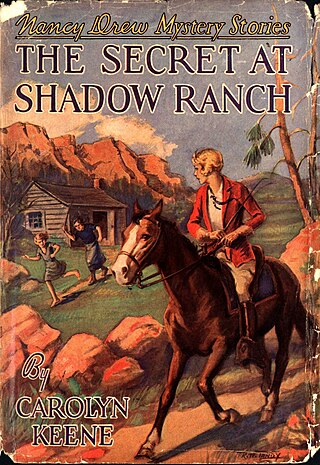
The Secret at Shadow Ranch is the fifth volume in the Nancy Drew Mystery Stories series. It was first published in 1931 under the pseudonym Carolyn Keene, and was ghostwritten by Mildred Wirt Benson. This book, as of 2001, ranks 50 on the list of All-Time Bestselling Children's Books, according to Publishers Weekly, with 2,347,750 sales since 1931.
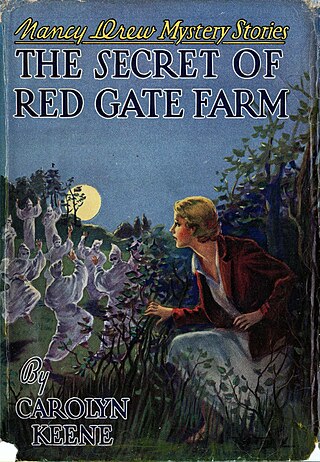
The Secret of Red Gate Farm is the sixth volume in the Nancy Drew Mystery Stories series, written under the pseudonym Carolyn Keene, It was first published in 1931.

The Clue in the Diary is the seventh volume in the Nancy Drew Mystery Stories series, and was first published in 1932 under the pseudonym Carolyn Keene. Its text was revised in 1962.
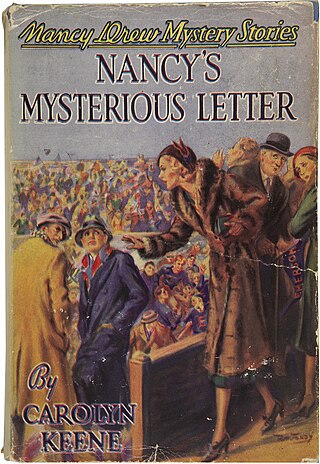
Nancy's Mysterious Letter is the eighth volume in the Nancy Drew Mystery Stories series. It was first published in 1932 and was penned by Walter Karig, a replacement writer for Mildred Wirt Benson. Benson declined series work when the Depression forced a reduction in the contract fee provided to Stratemeyer Syndicate writers, so Karig, already an established Stratemeyer writer, took over the authorship. Due to Karig having died in 1956, the 1932 version passed into the public domain in Canada and other countries that have a life plus 50 policy, in 2007.

The Clue of the Velvet Mask is the thirtieth volume in the original Nancy Drew Mystery Stories series. It was Mildred Benson's final ghostwrite for the series. The plot and story take place largely in Nancy's hometown of River Heights. Nancy tries to solve a mystery about a gang of event thieves robbing homes during parties, lectures, musicals, and other social occasions planned or catered by Lightner's Entertainment Company. Much of the original story contains elements of dramatic crime dramas; the villains are darker in tone than many other entries in the series.

The Sign of the Twisted Candles is the ninth volume in the Nancy Drew Mystery Stories series. As the second volume written by Walter Karig, it was originally published in 1933 under the pseudonym Carolyn Keene. Due to Karig having died in 1956, as of January 1, 2007, the 1933 book and the other two Nancy Drew books he wrote, have passed into the public domain in Canada and other countries with a life-plus-50 policy.

The Password to Larkspur Lane is the tenth volume in the Nancy Drew Mystery Stories series. It was first published in 1933 under the pseudonym Carolyn Keene. The actual author was ghostwriter Walter Karig in his third and final Nancy Drew novel and his final appearance for the Stratemeyer Syndicate. Due to Karig's death in 1956, this book and his other two Nancy Drews, as of January 1, 2007, have passed into the public domain in Canada and other countries with a life-plus-50 policy.

The Clue of the Broken Locket is the eleventh volume in the Nancy Drew Mystery Stories series. It was first published in 1934 and was written by Mildred Benson under the pseudonym Carolyn Keene. It was later revised by Harriet Stratemeyer in 1965, and the story was mostly changed with a few elements of the original.

The Whispering Statue is the fourteenth volume in the Nancy Drew Mystery Stories series. It was written by Mildred Wirt Benson, whom many readers and scholars consider the "truest" of the numerous Carolyn Keene ghostwriters, following an outline by Harriet Stratemeyer. The book was originally published by Grosset & Dunlap in 1937. An updated, revised, and largely different story was published under the same title in 1970.

The Mystery of the Ivory Charm is the thirteenth volume in the Nancy Drew Mystery Stories series. It was first published in 1936 under the pseudonym Carolyn Keene. The actual author was ghostwriter Mildred Wirt Benson.
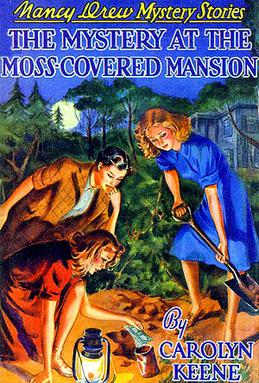
The Mystery at the Moss-Covered Mansion is the eighteenth volume in the Nancy Drew Mystery Stories series published by Grosset & Dunlap, and was first published in 1941. The original text was written by ghostwriter Mildred Wirt Benson, based upon a plot outline from Stratemeyer Syndicate co-owner Harriet Stratemeyer Adams. The book's title was changed to Mystery of the Moss-Covered Mansion when it was revised in 1971, because the story is completely different and not much of the investigation takes place at the title location. In the original, many plots and much investigation all tie back to the same house deep in the forest, while Nancy helps her father locate an heiress, expose an impostor, investigate a murder, and look into strange screams at the mansion; none of the action in the original story took place in River Heights.
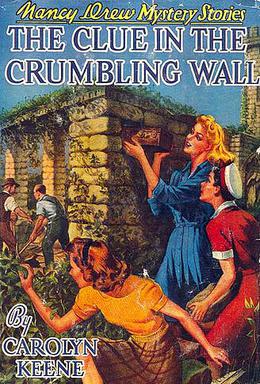
The Clue in the Crumbling Wall is the twenty-second volume in the Nancy Drew Mystery Stories series. It was first published in 1945 under Carolyn Keene, a pseudonym of the ghostwriter Mildred Wirt Benson.

The Mystery of the Tolling Bell is the twenty-third volume in the Nancy Drew Mystery Stories series. It was first published in 1946 under the pseudonym Carolyn Keene. The actual author was ghostwriter Mildred Wirt Benson.

The Ringmaster's Secret is the thirty-first volume in the Nancy Drew Mystery Stories series. It was first published in late 1953 under the pseudonym Carolyn Keene. The actual author was ghostwriter Harriet Stratemeyer Adams.

The Kay Tracey Mysteries were published under the name Frances K. Judd, a house pseudonym of the Stratemeyer Syndicate, a book packager. The series was conceived as a response to the popularity of the Nancy Drew Mystery Stories and likewise features a teenage girl detective. While the original entries in the series lasted only from 1934 to 1942, the books were updated, revised, and have been re-issued numerous times, most recently by Bantam Books in the 1980s, and have been translated into Swedish and French. Many critics see Kay Tracey as markedly inferior to Nancy Drew, but some find the series to be significant as one of a number of series that provided girls with a feminist role model prior to third-wave feminism.
The Nancy Drew Mystery Stories is the long-running "main" series of the Nancy Drew franchise, which was published under the pseudonym Carolyn Keene. There are 175 novels — plus 34 revised stories — that were published between 1930 and 2003 under the banner; Grosset & Dunlap published the first 56, and 34 revised stories, while Simon & Schuster published the series beginning with volume 57.



















